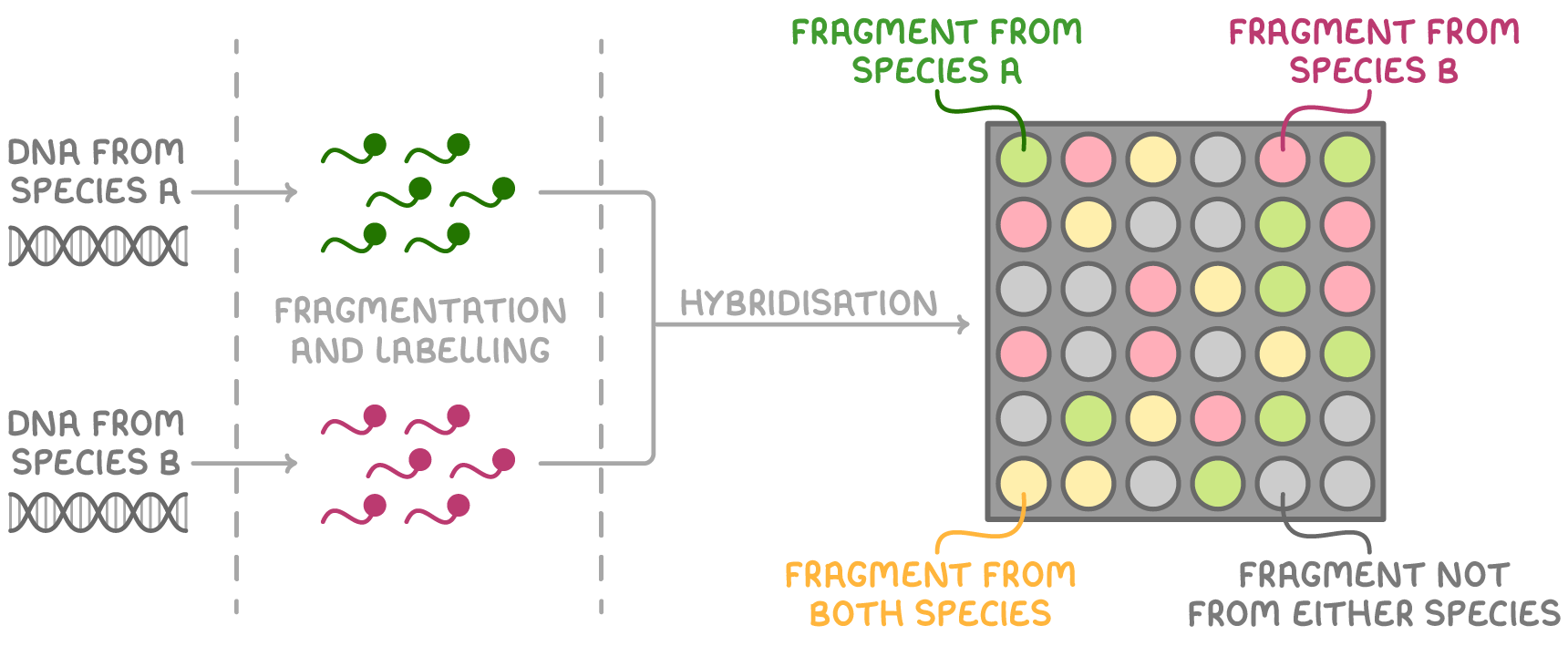DNA Probes & Genetic Screening
This lesson covers:
- Using DNA probes and microarrays
- Applications of DNA probes
- Genetic counselling
- Personalised medicine
- Gene therapy
What is a DNA probe?
A DNA probe is a short, labelled, single-stranded DNA sequence that can identify a specific allele. It does this by binding to a complementary DNA sequence. For example, a DNA probe can determine whether an individual carries a mutated allele responsible for a genetic disorder.
To create a DNA probe, the target allele's base sequence is first identified using DNA sequencing so that a complementary probe can be made. Then, the sequence is replicated using PCR.
The process of screening DNA for a specific allele using a DNA probe:
- Denaturation - An individual's DNA strands are heated causing them to separate into two single strands.
- Fragmentation - Digest the DNA sample into fragments using restriction enzymes.
- Mixing - Add fluorescently or radioactively labelled DNA probes.
- Hybridisation - DNA probes bind with the target sequence.
- Identification - Visualise any DNA probe that has hybridised to DNA fragments under UV light (for fluorescently labelled DNA probes) or X-ray (for radioactively labelled probes) to signal whether the allele is present.
DNA microarrays
DNA microarrays allow for the simultaneous screening of many genes using multiple DNA probes through a process called high-throughput screening. Glass microarray slides have many different immobilised DNA probes arranged in specific places on a grid.
For instance, it could be used to compare the genes in two different species, as shown in the image below.

How DNA microarrays work:
- Extract DNA from the species or cells of interest.
- Fragment and fluorescently label these DNA samples.
- Mix the labelled DNA and wash it over the microarray probes.
- DNA fragments that match any of the probes will hybridise.
- The array is then viewed under UV light.
- Any fluorescent spots show that the sample contains those fragments.
Applications of DNA probes in genetic screening
DNA probing facilitates the diagnosis and management of various genetic conditions.
Some applications include:
- Identifying individuals carrying specific alleles that may lead to genetic disorders like Huntington's disease and cystic fibrosis.
- Determining how patients will respond to certain drugs, which is crucial for targeted cancer therapies.
- Evaluating susceptibility to diseases due to inherited or mutated alleles, aiding in preventive healthcare decisions.
There are concerns that probes might lead to discrimination in insurance or employment by revealing high-risk alleles.
Genetic counselling
Genetic counselling uses the outcomes of genetic screening tests and research into family history to provide advice on the implications of genetic disorders in individuals and the risks of them being inherited by offspring.
This process involves:
- Discussing the significance and risks of screening tests.
- Clarifying the results and the likelihood of associated diseases developing in individuals and their offspring.
- Offering information on preventive measures or treatments if mutations are detected.
Genetic counselling helps individuals make informed decisions about family planning, risk-reducing surgeries, and other health-related choices.
Examples:
- Counselling an individual with a BRCA1 mutation about their elevated risk of breast cancer and preventive options such as mastectomy.
- Advising a couple, both carriers of the sickle cell anaemia allele, on the probability of having an affected child and possible interventions like embryo screening.
Personalised medicine and gene therapy
Genetic makeup influences how a person reacts to medications. Personalised medicine tailors healthcare for optimal treatment based on an individual's genetic makeup, ensuring the most effective drugs are chosen.
Gene therapy seeks to correct genetic disorders by:
- Silencing defective dominant alleles that could lead to dominant genetic disorders.
- Adding a working dominant allele to silence defective recessive alleles that could cause recessive genetic disorders.
- Using vectors such as viruses or liposomes to transport healthy alleles into cells.
- Focusing on somatic cells for treating individuals or germline cells to prevent passing the disease to offspring.